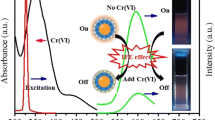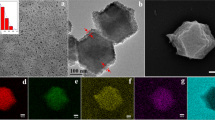Abstract
A sensitive molecularly imprinted ratiometric fluorescence sensor was constructed for the first time to visually detect tetrabromobisphenol A (TBBPA). The blue fluorescent carbon quantum dots (CQDs) were coated with SiO2 through the reverse microemulsion method to obtain a stable internal reference signal CQDs@SiO2. The ratiometric fluorescence sensor was finally prepared using red fluorescent CdTe QDs as the response signal in the presence of CQDs@SiO2. When the molecularly imprinted polymers were combined with TBBPA, the fluorescence of CdTe QDs (Ex = 365 nm, Em = 665 nm) was rapidly quenched, while that of CQDs (Ex = 365 nm, Em = 441 nm) remained stable, resulting in a noticeable fluorescence color change. Moreover, the fluorescence intensity ratio (I665/I441)0/(I665/I441) of the sensor showed a linear response to TBBPA in the concentration range 0.1 to 10 μM with a low detection limit of 3.8 nM. The prepared sensor was successfully applied to detect TBBPA in water samples. The recoveries were in the range 98.2–103%, with relative standard deviations lower than 2.5%. Furthermore, a fluorescent test strip for visual monitoring of TBBPA was constructed to streamline the procedure. The excellent results demonstrate that the prepared test strip has a broad prospect for the offline detection of pollutants.
Graphical abstract







Similar content being viewed by others
References
Li Y, Han D, Arai Y, Fu X, Li X, Huang W (2019) Kinetics and mechanisms of debromination of tetrabromobisphenol A by Cu coated nano zerovalent iron. Chem Eng J 373:95–103. https://doi.org/10.1016/j.cej.2019.04.182
Chen X, Zheng M, Zhou Y, Tong J, Wu K (2015) Electrochemical enhancement of acetylene black film as sensitive sensing platform for toxic tetrabromobisphenol A. RSC Adv 5:105837–105843. https://doi.org/10.1039/c5ra24040a
Zhou T, Zhao X, Xu Y, Tao Y, Luo D, Hu L, Jing T, Zhou Y, Wang P, Mei S (2020) Electrochemical determination of tetrabromobisphenol A in water samples based on a carbon nanotubes@zeolitic imidazole framework-67 modified electrode. RSC Adv 10:2123–2132. https://doi.org/10.1039/c9ra06980a
Li Y, Jiao Y, Guo Y, Yang Y (2013) Determination of bisphenol-A, 2,4-dichlorophenol, bisphenol-AF and tetrabromobisphenol-A in liquid foods and their packaging materials by vortex-assisted supramolecular solvent microextraction/high-performance liquid chromatography. Anal Methods 5:5037–5043. https://doi.org/10.1039/c3ay40586a
Inthavong C, Hommet F, Bordet F, Rigourd V, Guerin T, Dragacci S (2017) Simultaneous liquid chromatography-tandem mass spectrometry analysis of brominated flame retardants (tetrabromobisphenol A and hexabromocyclododecane diastereoisomers) in French breast milk. Chemosphere 186:762–769. https://doi.org/10.1016/j.chemosphere.2017.08.020
Bu D, Zhuang H, Zhou X, Yang G (2014) Biotin-streptavidin enzyme-linked immunosorbent assay for detecting Tetrabromobisphenol A in electronic waste. Talanta 120:40–46. https://doi.org/10.1016/j.talanta.2013.11.080
Ansari S, Ansari MS, Satsangee SP, Jain R (2021) Bi2O3/ZnO nanocomposite: Synthesis, characterizations and its application in electrochemical detection of balofloxacin as an anti-biotic drug. J Pharm Anal 11:57–67. https://doi.org/10.1016/j.jpha.2020.03.013
Ansari S, Ansari MS, Satsangee SP, Jain R (2019) WO3 decorated Graphene nanocomposite based electrochemical sensor: A prospect for the detection of anti-anginal drug. Anal Chim Acta 1046:99–109. https://doi.org/10.1016/j.aca.2018.09.028
Ansari S, Ansari MS, Devnani H, Satsangee SP, Jain R (2018) CeO2/g-C3N4 nanocomposite: A perspective for electrochemical sensing of anti-depressant drug. Sens Actuators B Chem 273:1226–1236. https://doi.org/10.1016/j.snb.2018.06.036
Devnani H, Ansari S, Satsangee SP, Jain R (2017) ZrO2-Graphene-Chitosan nanocomposite modified carbon paste sensor for sensitive and selective determination of dopamine. Mater Today Chem 4:17–25. https://doi.org/10.1016/j.mtchem.2017.02.004
Ansari S, Ansari MS, Satsangee SP, Alam MG, Jain R (2022) Electrochemical sensing platform based on ZrO2/BiVO4 nanocomposite for gastro-prokinetic drug in human blood serum. J Nanostruct Chem. https://doi.org/10.1007/s40097-022-00473-6
Myriam D-Á, Antonio M-E (2021) Molecularly imprinted polymer-quantum dot materials in optical sensors: An overview of their synthesis and applications. Biosensors 11:79. https://doi.org/10.3390/bios11030079
Chen YP, Wang DN, Yin YM, Wang LY, Wang XF, Xie MX (2012) Quantum dots capped with dummy molecularly imprinted film as luminescent sensor for the determination of tetrabromobisphenol A in water and soils. J Agric Food Chem 60:10472–10479. https://doi.org/10.1021/jf3026138
Baldoneschi V, Palladino P, Banchini M, Minunni M, Scarano S (2020) Norepinephrine as new functional monomer for molecular imprinting: An applicative study for the optical sensing of cardiac biomarkers. Biosens Bioelectron. 157:112161. https://doi.org/10.1016/j.bios.2020.112161
Li Z, Hu J, Lou Z, Zeng L, Zhu M (2021) Molecularly imprinted photoelectrochemical sensor for detecting tetrabromobisphenol A in indoor dust and water. Microchim Acta 188:320. https://doi.org/10.1007/s00604-021-04980-1
Saraji M, Alijani S (2021) A molecularly imprinted polymer on chromium (III) oxide nanoparticles for spectrofluorometric detection of bisphenol A. Spectrochim Acta A Mol Biomol Spectrosc 255:119711. https://doi.org/10.1016/j.saa.2021.119711
Li Y, He W, Peng Q, Hou L, He J, Li K (2019) Aggregation-induced emission luminogen based molecularly imprinted ratiometric fluorescence sensor for the detection of Rhodamine 6G in food samples. Food Chem 287:55–60. https://doi.org/10.1016/j.foodchem.2019.02.081
Song E, Han W, Xu H, Jiang Y, Cheng D, Song Y, Swihart MT (2014) Magnetically encoded luminescent composite nanoparticles through layer-by-layer self-assembly. Chem Eur J 20:14642–14649. https://doi.org/10.1002/chem.201403699
Hao T, Wei X, Nie Y, Xu Y, Yan Y, Zhou Z (2016) An eco-friendly molecularly imprinted fluorescence composite material based on carbon dots for fluorescent detection of 4-nitrophenol. Microchim Acta 183:2197–2203. https://doi.org/10.1007/s00604-016-1851-2
Long R, Li T, Tong C, Wu L, Shi S (2019) Molecularly imprinted polymers coated CdTe quantum dots with controllable particle size for fluorescent determination of p-coumaric acid. Talanta 196:579–584. https://doi.org/10.1016/j.talanta.2019.01.007
Fu Q, Long C, Qin L, Jiang Z, Qing T, Zhang P, Feng B (2021) Fluorescent and colorimetric dual-mode detection of tetracycline in wastewater based on heteroatoms-doped reduced state carbon dots. Environ Pollut 283:117109. https://doi.org/10.1016/j.envpol.2021.117109
Gui W, Wang H, Liu Y, Ma Q (2018) Ratiometric fluorescent sensor with molecularly imprinted mesoporous microspheres for malachite green detection. Sens Actuators B Chem 266:685–691. https://doi.org/10.1016/j.snb.2018.03.176
Guan Y, Yang Y, Wang X, Yuan H, Yang Y, Li N, Ni C (2021) Multifunctional Fe3O4@SiO2-CDs magnetic fluorescent nanoparticles as effective carrier of gambogic acid for inhibiting VX2 tumor cells. J Mol Liq 327:114783. https://doi.org/10.1016/j.molliq.2020.114783
Venkatachalam V, Ganapathy S, Priyadarshini N, Perumal I (2022) Indium doped CdTe colloidal quantum dots stabilised in aqueous medium for white light emission. Colloids Surf A: Physicochem Eng Aspects 653:129891. https://doi.org/10.1016/j.colsurfa.2022.129891
Kanagasubbulakshmi S, Kadirvelu K (2018) Nano interface potential influences in CdTe quantum dots and biolabeling. Appl Nanosci 8:285–295. https://doi.org/10.1007/s13204-018-0774-0
Shao H, Li C, Ma C, Sun L, Chen R, Cheng R, Liu Y, Yan Y, Sun Q, Wu C (2017) An ion-imprinted material embedded carbon quantum dots for selective fluorometric determination of lithium ion in water samples. Microchim Acta 184:4861–4868. https://doi.org/10.1007/s00604-017-2493-8
Farahmandzadeh F, Molaei M, Karimipour M, Shamsi AR (2020) Highly luminescence CdTe/ZnSe core–shell QDs; synthesis by a simple low temperature approach. J Mater Sci Mater Electron 31:12382–12388. https://doi.org/10.1007/s10854-020-03784-y
Gong T, Tang Y (2020) Preparation of multifunctional nanocomposites Fe3O4@SiO2-EDTA and its adsorption of heavy metal ions in water solution. Water Sci Technol 81:170–177. https://doi.org/10.2166/wst.2020.099
Zhu W, Zhou Y, Liu S, Luo M, Du J, Fan J, Xiong H, Peng H (2021) A novel magnetic fluorescent molecularly imprinted sensor for highly selective and sensitive detection of 4-nitrophenol in food samples through a dual-recognition mechanism. Food Chem 348:129126. https://doi.org/10.1016/j.foodchem.2021.129126
Raksawong P, Nurerk P, Chullasat K, Kanatharana P, Bunkoed O (2019) A polypyrrole doped with fluorescent CdTe quantum dots and incorporated into molecularly imprinted silica for fluorometric determination of ampicillin. Microchim Acta 186:338. https://doi.org/10.1007/s00604-019-3447-0
Jia M, Zhang Z, Li J, Shao H, Chen L, Yang X (2017) A molecular imprinting fluorescence sensor based on quantum dots and a mesoporous structure for selective and sensitive detection of 2, 4-dichlorophenoxyacetic acid. Sens Actuators B Chem 252:934–943. https://doi.org/10.1016/j.snb.2017.06.090
Zhou Y, Qu ZB, Zeng Y, Zhou T, Shi G (2014) A novel composite of graphene quantum dots and molecularly imprinted polymer for fluorescent detection of paranitrophenol. Biosens Bioelectron 52:317–323. https://doi.org/10.1016/j.bios.2013.09.022
Yang Q, Li J, Wang X, Peng H, Xiong H, Chen L (2019) Dual-emission color-controllable nanoparticle based molecular imprinting ratiometric fluorescence sensor for the visual detection of Brilliant Blue. Sens Actuators B Chem 284:428–436. https://doi.org/10.1016/j.snb.2018.12.134
Wang X, Yu J, Wu X, Fu J, Kang Q, Shen D, Li J, Chen L (2016) A molecular imprinting-based turn-on Ratiometric fluorescence sensor for highly selective and sensitive detection of 2, 4-dichlorophenoxyacetic acid (2, 4-D). Biosens Bioelectron 81:438–444. https://doi.org/10.1016/j.bios.2016.03.031
Chao J, Zeng L, Li R, Zhou Y (2021) Molecularly imprinted polymer-capped wrinkled silica-quantum dot hybrid particles for fluorescent determination of tetra bromo bisphenol A. Microchim Acta 188:126. https://doi.org/10.1007/s00604-021-04779-0
Feng J, Tao Y, Shen X, Jin H, Zhou T, Zhou Y, Hu L, Luo D, Mei S, Lee Y-I (2019) Highly sensitive and selective fluorescent sensor for tetrabromobisphenol-A in electronic waste samples using molecularly imprinted polymer coated quantum dots. Microchem J 144:93–101. https://doi.org/10.1016/j.microc.2018.08.041
Acknowledgements
This work was supported by the National Natural Science Foundation of China (Program No. 21806097), Scientific Research Program Funded by Shaanxi Provincial Education Department (Program No. 18JK0104), and Research Starting Foundation of Shaanxi University of Science and Technology (Program No. 2016BJ-80).
Author information
Authors and Affiliations
Contributions
Yanming Shao: Conceptualization; Investigation; Methodology; Data curation; Supervision; Writing-original draft; Writing-review & editing. Peng Wang: Investigation; Methodology; Formal analysis; Data curation; Validation; Writing-original draft; Writing-review & editing. Rui Zheng: Methodology; Formal analysis. Zhizhen Zhao: Investigation; Data curation. Jun An: Resources; Validation. Caifeng Hao: Data curation. Mengyi Kang: Validation.
Corresponding author
Ethics declarations
Conflicts of interest
The authors declare they have no conflicts of interest.
Additional information
Publisher's note
Springer Nature remains neutral with regard to jurisdictional claims in published maps and institutional affiliations.
Supplementary information
Below is the link to the electronic supplementary material.
Rights and permissions
Springer Nature or its licensor (e.g. a society or other partner) holds exclusive rights to this article under a publishing agreement with the author(s) or other rightsholder(s); author self-archiving of the accepted manuscript version of this article is solely governed by the terms of such publishing agreement and applicable law.
About this article
Cite this article
Shao, Y., Wang, P., Zheng, R. et al. Preparation of molecularly imprinted ratiometric fluorescence sensor for visual detection of tetrabromobisphenol A in water samples. Microchim Acta 190, 161 (2023). https://doi.org/10.1007/s00604-023-05745-8
Received:
Accepted:
Published:
DOI: https://doi.org/10.1007/s00604-023-05745-8




